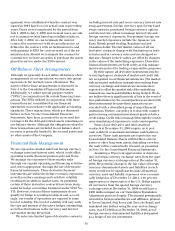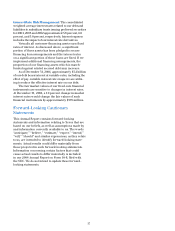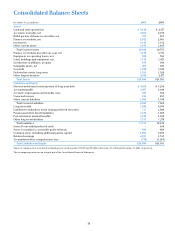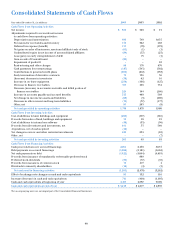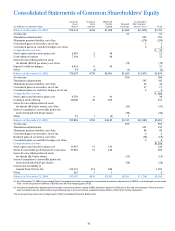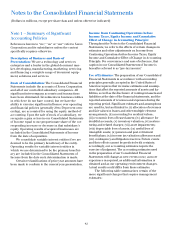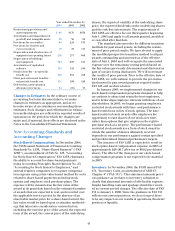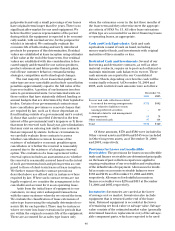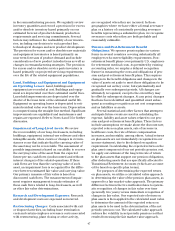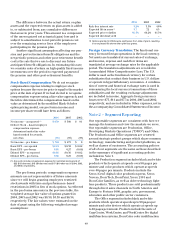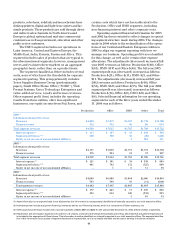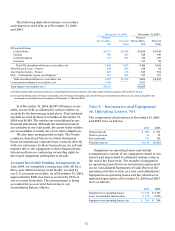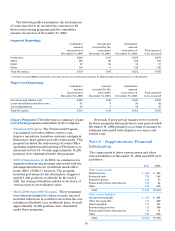Xerox 2004 Annual Report Download - page 48
Download and view the complete annual report
Please find page 48 of the 2004 Xerox annual report below. You can navigate through the pages in the report by either clicking on the pages listed below, or by using the keyword search tool below to find specific information within the annual report.
46
pal products and only a small percentage of our leases
have original terms longer than five years. There is no
significant after-market for our used equipment. We
believe that five years is representative of the period
during which the equipment is expected to be economi-
cally usable, with normal service, for the purpose for
which it is intended. We continually evaluate the
economic life of both existing and newly introduced
products for purposes of this determination. Residual
values are established at lease inception using estimates
of fair value at the end of the lease term. Our residual
values are established with due consideration to fore-
casted supply and demand for our various products,
product retirement and future product launch plans,
end of lease customer behavior, remanufacturing
strategies, competition and technological changes.
The vast majority of our leases that qualify as
sales-type are non-cancelable and include cancellation
penalties approximately equal to the full value of the
lease receivables. A portion of our business involves
sales to governmental units. Governmental units are
those entities that havestatutorily defined funding or
annual budgets that are determined by their legislative
bodies. Certain of our governmental contracts may
havecancellation provisions or renewal clauses that
are required bylaw, such as 1) those dependant on
fiscal funding outside of a governmental unit’s control,
2) those that can be cancelled if deemed in the best
interest of the governmental unit’staxpayers or 3) those
that must be renewed each fiscal year, given limitations
that may exist on entering into multi-year contracts
that are imposed bystatute. In these circumstances,
we carefully evaluate these contracts to assess
whether cancellation is remote because of the
existence of substantiveeconomic penalties upon
cancellation or whether the renewal is reasonably
assured due to the existence of a bargain renewal
option. The evaluation of a lease agreement with a
renewal option includes an assessment as to whether
the renewal is reasonably assured based on the intent
of such governmental unit and pricing terms as com-
pared to those of short-term leases at lease inception.
We further ensure that the contract provisions
described above are offered only in instances where
required by law. Where such contract terms are not
legally required, we consider the arrangement to be
cancelable and account for it as an operating lease.
Aside from the initial lease of equipment to our
customers, we may enter subsequent transactions
with the same customer whereby we extend the term.
We evaluate the classification of lease extensions of
sales-type leases using the originally determined eco-
nomic life for each product. There may be instances
where we enter into lease extensions for periods that
are within the original economic life of the equipment.
These are accounted for as sales-type leases only
when the extensions occur in the last three months of
the lease term and they otherwise meet the appropri-
ate criteria of SFAS No. 13. All other lease extensions
of this type are accounted for as direct financing leases
or operating leases, as appropriate.
Cash and Cash Equivalents: Cash and cash
equivalents consist of cash on hand, including
money-market funds, and investments with original
maturities of three months or less.
Restricted Cash and Investments: Several of our
borrowing and derivative contracts, as well as other
material contracts, require us to post cash collateral or
maintain minimum cash balances in escrow. These
cash amounts are reported in our Consolidated
Balance Sheets, depending on when the cash will be
contractually released. At December 31, 2004 and
2003, such restricted cash amounts were as follows:
December 31,
2004 2003
Escrowand cash collections related
to secured borrowing arrangements $372 $462
Escrow related to liability to trusts
issuing preferred securities —79
Collateral related to risk management
arrangements 61 74
Other restricted cash 97 114
Total $530 $729
Ofthese amounts, $370and $386 were included in
Other current assets and $160 and $343 were included
in Other long-term assets, as of December 31, 2004
and 2003, respectively.
Provisions for Losses on Uncollectible
Receivables: The provisions for losses on uncollectible
trade and finance receivables are determined principally
on the basis of past collection experience applied to
ongoing evaluations of our receivables and evaluations
of the default risks of repayment. Allowances for doubt-
ful accounts on accounts receivable balances were
$183and $218, as of December 31, 2004 and 2003,
respectively. Allowances for doubtful accounts on
finance receivables were $276 and $315 at December
31, 2004 and 2003, respectively.
Inventories: Inventories are carried at the lower
of average cost or market. Inventories also include
equipment that is returned at the end of the lease
term. Returned equipment is recorded at the lower
of remaining net book value or salvage value. Salvage
value consists of the estimated market value (generally
determined based on replacement cost) of the salvage-
able component parts, which are expected to be used


